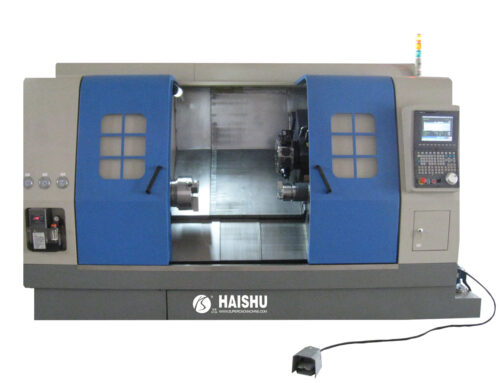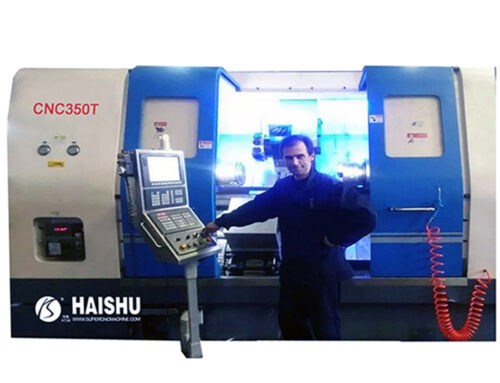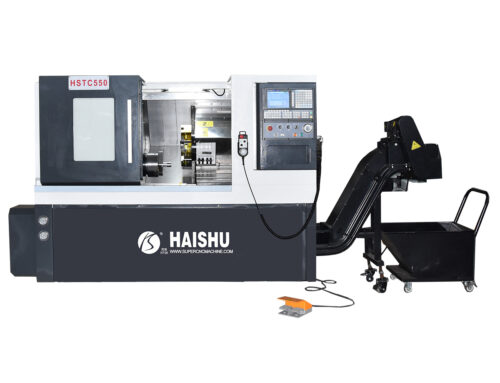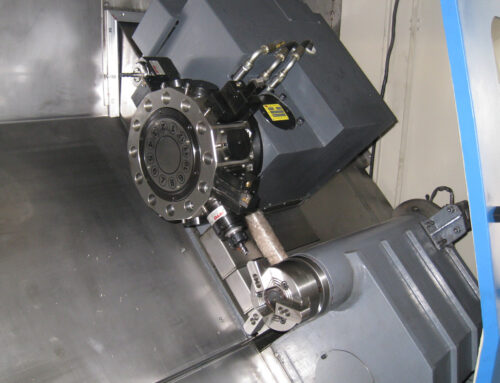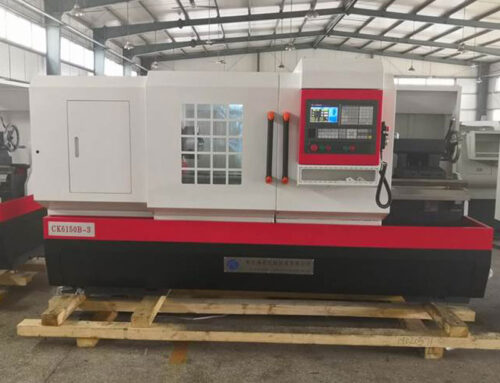Advanced Structural Design of CNC Slant Bed Lathes
CNC Slant Bed Lathes represent a pinnacle in the evolution of CNC lathe metalworking tools, designed for fabricating rotationally symmetrical components with utmost precision. These sophisticated devices are the backbone of modern manufacturing, where precision, stability, and efficiency are non-negotiable.
The Bed: A Foundation of Stability
The main body of the CNC machine, specifically the CNC Slant Bed Lathe, is the bed—a sturdy cast iron base designed to handle intense machining operations. The slant in the bed’s structure is more than just a design choice; it’s a functional feature that significantly improves the distribution of cutting forces, which, in turn, boosts the machine’s stability and rigidity.
The Spindle Box: Core of Rotation
At one extremity of the bed of the CNC lathe machine, the spindle box is mounted, encapsulating the spindle, its bearings, the drive system, and the gearbox. This unit is essential in securing the workpiece and providing the necessary rotation. Thanks to the spindle bearings and the robust drive system, the CNC lathe can deliver power efficiently, while the gearbox offers fine control over the spindle’s speed and torque.
Tool Holder and Carriage: Precision Tooling Essentials
Opposite the spindle box, the tool holder of the CNC lathe is strategically placed. With its ability to support various control modes—servo-driven, hydraulic, electric, or manual—it provides flexibility and precision in cutting tool management. Features such as automatic tool change and tool compensation are critical for streamlining the machining process on a CNC lathe.
The carriage works in unison with the tool holder, anchoring the feed system which consists of a motor, ballscrew, and linear guide rails. This setup in the CNC metal lathe not only facilitates precise workpiece feeding but also ensures the proper retraction of tools, vital for achieving the desired accuracy and surface finish.
The Feed System and Control System: Ensuring Accuracy
The feed system of the CNC metal lathe is a marvel of engineering, incorporating feed motors and guide rails to control the workpiece’s movement with incredible precision. It’s the feed system that dictates the speed and position during machining, directly impacting the quality of the final product on a CNC lathe.
At the command center is the control system, the brain of the CNC Slant Bed Lathe. It integrates cutting-edge numerical control systems from industry giants like Fanuc and Siemens, alongside servo systems, encoders, and sensors. The control system orchestrates every aspect of the machining process on the CNC lathe, ensuring every cut meets the stringent standards required.
In conclusion, the synergy of these components in the CNC Slant Bed Lathe drives high precision, efficiency, and automation, making it an essential asset in the metalworking industry and reaffirming its status as a top-tier CNC lathe.
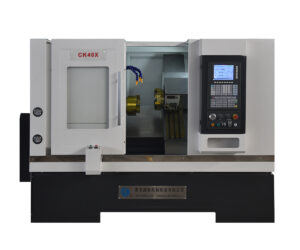
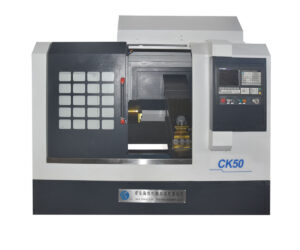
Optimizing CNC Slant Bed Lathe Tooling with Advanced Design
The structural integrity of CNC Slant Bed Lathes is pivotal to their operational efficiency and precision. At the heart of these machine tools is the bed, a robust cast iron foundation that supports the rigorous demands of CNC machining. Its sloped design is not just aesthetic but functional, distributing cutting forces more evenly which is crucial for maintaining the rigidity and stability of the machine.
Bed Design: Ensuring Precision and Longevity
The Importance of Bed Rigidity
The bed’s design directly affects the CNC Slant Bed Lathe’s accuracy, reliability, and service life. Utilizing a thick-walled design, its rigidity is enhanced through finite element analysis, ensuring minimal vibration during operation. The bed undergoes aging treatments to relieve internal stresses, which solidifies its rigidity and prevents future deformation.
Machining and Calibration
Post-aging, precision grinding and meticulous calibration are essential. A large gantry machine is often employed to maintain absolute parallelism and flatness, ensuring the bed meets exacting standards. The sloped design not only facilitates improved machining precision but also aids in chip removal and coolant management, thereby reducing maintenance.
Spindle Box: The Heart of Speed and Torque Control
Spindle Box Variants and Design
The spindle box, a cornerstone of the CNC Slant Bed Lathe, houses the spindle and its drive system, playing a crucial role in spindle rotation and speed adjustment. Selecting the appropriate bearings is vital for achieving desired accuracy and extending the spindle’s lifespan. Modern spindle boxes typically adopt an integrated unit structure, combining high rigidity with easy maintenance.
Gearbox Integration
Gearbox technology within the spindle box is advancing, with future designs expected to become more compact. It is critical to select and maintain the gearbox in alignment with the machine’s operational requirements to ensure consistent performance.
Tool Post: Precision Tool Clamping and Support
Tool Post Structure
The tool post of a CNC Slant Bed Lathe is key for clamping and supporting cutting tools during machining. Comprising a base, movable support, tool post body, and clamping mechanism, the tool post must be constructed with precision to ensure the stability and accuracy of the tool during the cutting process.
Tool Post Stability
The stability of the tool post is paramount, with the base typically made of durable cast iron. The movable support allows for height adjustments along the guide rail, while the clamping mechanism secures the tool in place.
By focusing on these critical components, manufacturers can ensure the CNC Slant Bed Lathe operates at peak performance. Regular maintenance and adherence to precise engineering standards are necessary to sustain the high quality of machining that these lathes are known for. The design and manufacturing quality of the bed, spindle box, and tool post are fundamental to the CNC Slant Bed Lathe’s capabilities, ensuring it remains an indispensable tool in precision metalworking.
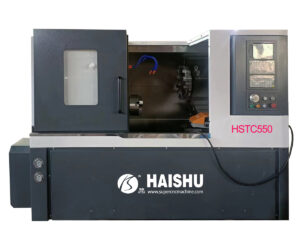
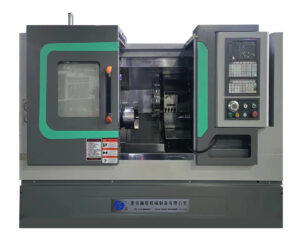
Precision Tooling and Guides in CNC Slant Bed Lathes
Enhancing Machining with Diverse Tool Posts
CNC Slant Bed Lathes are equipped with a variety of tool posts, each tailored to specific machining tasks. Square tool posts are the go-to choice for rough machining and heavy-duty cutting. For precision machining and high-speed cutting, hexagonal tool posts are preferred, while turret tool posts excel in processing thin-walled pipes and sheet metal.
The Power Behind the Performance
Tool posts are powered electrically, hydraulically, or via servo drives. Electric and hydraulic systems are robust, ideal for heavy-duty cutting. Servo turrets, on the other hand, cater to complex machining needs, capable of turning, milling, drilling, and grinding, thus enhancing the versatility of CNC Slant Bed Lathes.
Maintenance for Optimal Precision
Regular maintenance of the tool post is crucial. Ensuring the clamping mechanism functions correctly and replacing worn parts promptly are vital to maintain clamping force and tool accuracy. Routine cleaning and lubrication of the tool post’s components prolong its service life and ensure consistent machining precision.
Linear Guides: The Path to Precision
Variety of Guides for Every Need
The linear guide is a critical component of CNC Slant Bed Lathes, responsible for the stability and accuracy of the machine’s moving parts. There are several types, each with distinct advantages:
- Linear Guides: These are standard in high-speed and precision machine tools, boasting high rigidity, precision, and low noise, suitable for high-speed cutting and precision processing.
- Roller Guides: With rollers as the rolling elements, these guides are designed for high load capacity and rigidity, perfect for heavy-duty cutting.
- Sliding Block Guides: Known for their high rigidity and wear resistance, these are ideal for medium and small machine tools engaged in heavy-duty cutting.
- Linear Rolling Guides: Utilizing ball or roller bearings, they provide high precision and rigidity, favorable for high-speed cutting and high-precision machining.
- Gear Rack Guides: With a gear and rack meshing, they excel in load capacity and vibration resistance, making them suitable for large machine tools.
Selecting the Right Guide
Choosing the appropriate linear guide is essential. It must align with the specific processing requirements and the performance capabilities of the CNC Slant Bed Lathe to ensure stable, accurate machining. By understanding the distinctive features of each guide type, manufacturers can optimize the performance of their CNC Slant Bed Lathes, ensuring they meet the demanding standards of modern machining.
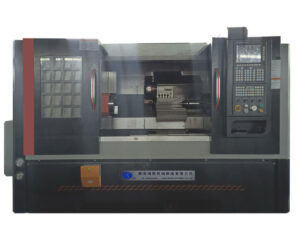
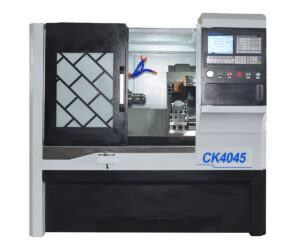
Elevate Your Machining with Taian HAISHU’s CNC Excellence
Taian HAISHU Machinery Co., Ltd. distinguishes itself as a seasoned CNC Slant Bed Lathes manufacturer, offering unparalleled precision and stability in its machine tools. Renowned for advanced production capabilities and a robust technical team, HAISHU delivers cost-effective CNC solutions that have earned a global reputation for quality and reliability, particularly their flagship CK40X Slant-Bed CNC Lathe.
Designed for demanding industries, the CK40X boasts high spindle speeds (2500-3000rpm), a sizable machining diameter (φ400mm), and significant axis travels (X: 250mm, Z: 750mm). With an 8-station turret and GSK980TDc control system, it ensures complex tasks are performed with utmost accuracy and efficiency. Safety and ease-of-use are prioritized with comprehensive protections and a user-friendly USB interface.
Committed to innovation and customer satisfaction, HAISHU focuses on expanding its reach, increasing exports, and customizing services to cater to unique client needs. By continuously advancing technology and enhancing product quality, they strive to solidify their position as a leading global brand in the machine tool industry. Choose HAISHU for machine tools that redefine industry standards and drive competitive production.
